We’ve mentioned them several times in passing before, but today we are dedicating an entire post to what is undoubtedly our favourite bean that we have ever grown or eaten: the pea bean. We first started growing these five years ago, purely for their looks. But when we came to cook them we were won over – we’ve never gone a year without them since.
Although older textbooks sometimes classify them otherwise, pea beans are now categorised as Phaseolus vulgaris: French or ‘kidney’ beans. Pea beans are climbing beans that produce white flowers followed by short pods. The pods start flat but fill out quickly with delicious meaty beans, similar to broad beans in texture, but with thinner skins. These beans are very versatile and can be used to great effect at any stage from flat pod to plump bean.
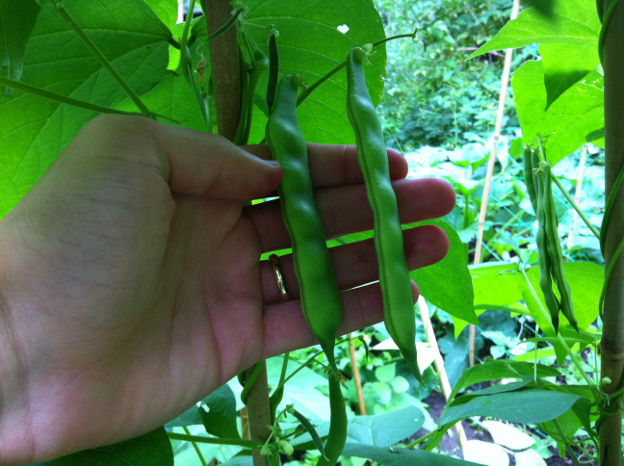
Pea beans growing in our vegetable patch.
In a conversation about French beans with a local smallholder a few years ago I mentioned that we always grow pea beans, half expecting that he would never have heard of them, as that had been my experience from every gardener/allotment holder that I had spoken to. To my delight he was very familiar with them. He said that he not only grew them, but that he preferred them to runner beans because they are high yielding, but unlike runner beans they never get stringy.
The fact that they don’t get stringy allows for the beans to be cooked and eaten in the pods even once the beans are fully formed. Alternatively at this stage the beans can be podded and used in soups, stews or curries. We allow a lot of ours to dry on the plant and shell them once fully dried to be used over the winter. We then leave them to soak overnight, rinse them and use them as though fresh. Using them before the beans are fully formed will of course encourage a higher yield, so early in the season we tend to use the pods whilst young and treat them like any other French bean.
The appearance of the bean is very striking. As can be seen in the image at the top of this post, when dried the bean is half maroon and half white. Our beans for winter storage look like this. However, if the beans are podded whilst still fresh the markings are almost invisible and the beans are green.
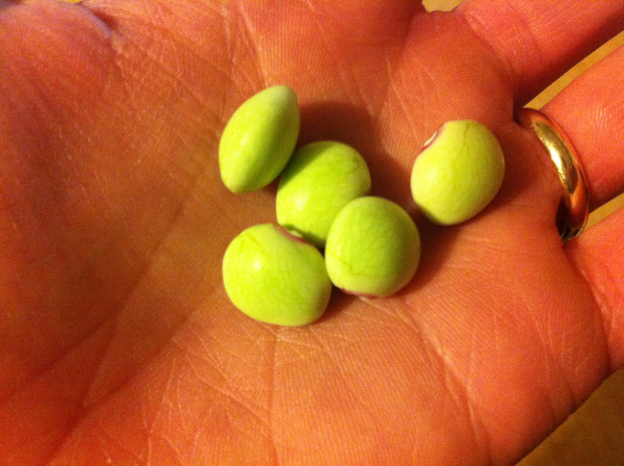
Podded fresh pea beans – almost unrecognisable from their dried state.
However, cooking the bean brings out the markings and the colours somewhat return, although not as vividly as in the bean’s dried state. This is demonstrated in the image below: what was a green fresh pea bean cooked in a stew. In case you were wondering the stew in the photo was Hugh Fearnley-Whittingstall’s porotos granados (Chilean squash stew) recipe from his excellent River Cottage Veg Everyday! book. The recipe almost followed to the letter, except for the addition of our home-grown runner beans.
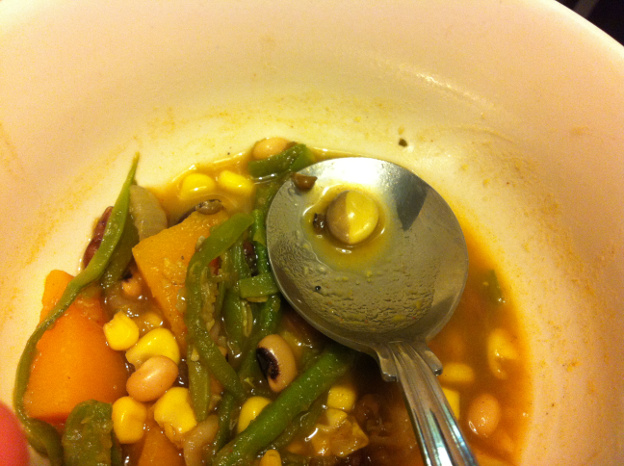
A cooked pea bean. Its distinctive markings and colours returned, albeit not as vibrantly as in its dried form.
It is strange that pea beans aren’t grown more widely in the UK. They are very easy to grow. We’ve been growing them for five years and never had any problems with them at all. Until last year we had always grown them in large pots, four or five plants around a wigwam of bamboo canes. As we had more space last year we started them in pots and moved them out into the vegetable patch once they were established. Wherever we’ve grown them they have always thrived.
Saving the seeds couldn’t be easier. French beans nearly always self-pollinate, so cross pollination shouldn’t be an issue. As a precaution it’s best to leave a few metres between this and any other French bean crops (they won’t cross with other beans such as runner beans or broad beans). Leave some typical looking pods on the plant (i.e. we don’t want to be saving pods with only two beans in) to dry. If the weather is too damp to allow for this, bring some mature pods indoors and hang them to dry. Once the pods are have turned parchment-like and the beans are rock hard, store them in a cool, dry and preferably dark place. Next year plant these to get your next harvest of pea beans. Any surplus saved beans can of course be soaked overnight and consumed. We have saved our pea beans this way every year and never had any cross-pollination issues.
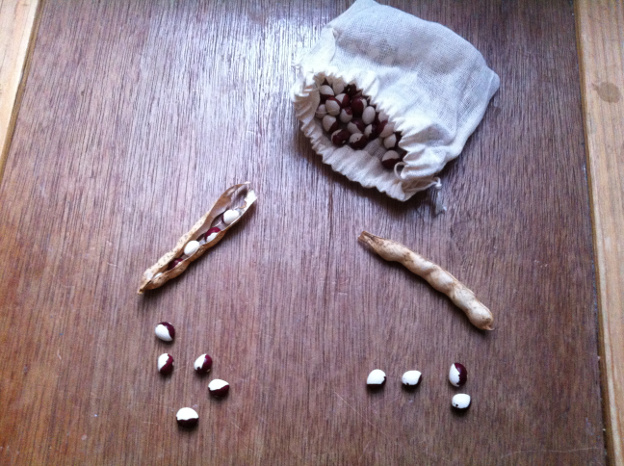
The source of this year’s crop – last year’s home saved pea beans.
Adding to the mystery of why pea beans aren’t more widely grown in the UK is the fact that they have been grown here for a very long time. They feature in Gerard’s Herbal, first published in 1597. They are listed as one of the interesting French bean varieties in Sue Stickland’s Back Garden Seed Saving book, where she says that one strain of them that was sent to the Heritage Seed Library traces its origins back the Second World War ‘Dig For Victory’ campaign. So they were grown as far back as the sixteenth century and as recently as the 1940s, and yet very few people seem to be familiar with them.
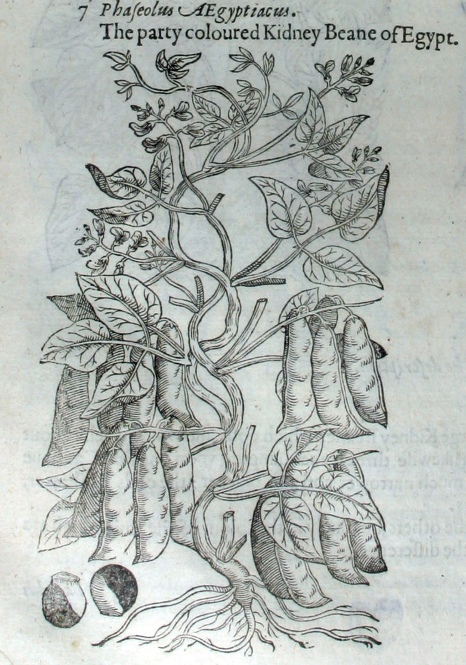
The Pea Bean in Gerard’s Herbal – a sixteenth century reference to this most striking bean. Image: www.BioLib.de
Everyone who has grown them at my suggestion and every review I’ve managed to find of them agrees that they are easy to grow, reliable, high yielding, very versatile and absolutely delicious. Added to that is the bonus that you only ever need one set of seeds and you can easily save your own (and thus truly become self-sufficient in them). So although I don’t know why they aren’t grown more widely, I do know that we shall continue to grow them and we are doing our part to spread the word. Give pea beans a try – your only regret will be that you hadn’t found them sooner!



I’d read your blog last month and had been wondering where I could get my hands on some of these when I spotted a bag of them for sale in my local market today! Going to enjoy most of them in tasty stews then plant some out in the spring – can’t wait! Thanks for the article.
Hi Anna,
Thanks for the comment. A very good find at your local market! We’ve only ever seen them for sale online. How were they being sold, dried and shelled? I’m sure you’ll love them as much as we do.
Matt
I totally agree, one of the best.
When you say French bean, what do you mean by that?
I am glad to have found these again.
My father had a part time gardening job in the 60’s for Pasha Glubb.
He brought home a few seeds and we enjoyed them for yes.
Lost contact with these when my father died.
Back in the 1960s a professor in my village (a keen gardener) bought some seed by mail order , he saved seed and shared them with friends. About 10 years ago I was helping an elderly neighbour in her garden and she had saved seeds every year from those original ones. She gave me some so I grew them ,yes they are delicious and easy to grow, never stringy and are cooked whole, they produce all summer long .
Love them cooked with home grown tomatoes and onions in a saucepan and some new potatoes.
I always save seed and share them with people who would like to try them.
I have some going spare. Happy gardening
A neighbour gave me five of these Pea Beans early in 2022 so I thought that I would give them a go. They were sown in a seed compost in the greenhouse in mid April. I was dissapointed in the 40% germination rate (after16 days) but I persevered. They were planted out a week after germinaion in the second week of May.
Their vigorous growth contrasted with the problem of poor germination. We cropped and steamed them for the table from the end of June until almost the end of September. I kept some pods and dried them. So after having had almost three month’s harvest, I stll had 118g of beans for next year’s crop and mabe a stew or two! I shall definately be sowing them next season with, hopefully better germination.
An old professor in my village (. Holme next the Sea) bought some in the 1960s; he gave seeds to my neighbour, and she grew and saved seeds every year: when she got older and needed a hand in her garden I would go round and help, she gave me some seeds about 15 years ago and I have been growing them every year since,, they are my wife’s and my favourite beans. Another good bean is a dwarf bean ‘. Ying Yan’ from Marshals seeds. The seeds are half black and half white, stringless and good croppers
Yes – some local market that – which one was that – can’t imagine finding them at Coventry market!
I happened to get some pea bean seeds at the Bedworth Seed Swap event and this article has made me especially look forward to trying them.
This item on Majorcan Pea Beans
https://www.gardenorganic.org.uk/seeds/french-bean-majorcan-pea-bean#:~:text=The%20seeds%20are%20the%20typical,used%20as%20a%20drying%20bean.
though suggests they can be a little stringy. Do you think these are the same variety?
Hi,
My friend gave me a few Pea Bean seeds and now I have my first harvest. I am so thrilled as I’ve never heard of them before, but how do I cook them, please? I was going to cook them whole for about 8 minutes, but now not sure. I would be so grateful to know how long is best. Thank you.
Kind regards
Jennie
We have been growing pea-beans in our family for over 70 years. I got them from my grandfather. We too love them and always look forward to the first tender crop. Interestingly in the last two years we have experienced some hybridization with a purple French bean we mistakenly planted close by. The pods are longer and thinner but the seed simply a little more oval and difficult to distinguish. The mauve flowers are a give away. We have once or twice had a hybrid with a runner bean but this produced a large blotchy bean seed which was quite obvious. Well done for finding and promoting these beans. Long live the pea-bean!
I received some off these bean from my late friend and he never let me know the name of them. Could it be possible to have their name please.
I planted them this year and are cropping well already. 😋 they taste delicious.
Robert.
I hate growing peas. Having to find pea sticks and then I forget them and they’re past their best or maggoty.
With these ‘pea beans’, they can be picked at any stage and as they’re climbing, there’s no grovelling on the ground as with peas and they do have a pea taste, especially as a whole pod, picked early.
I obtained mine from a kind allotment holder.
I have been growing Pea Beans since about 2005-6. A new friend offered them to me saying they can be eaten mangetout through to fully formed. I have tried to introduce other gardeners to grow them but with very little success. At the end of the season I save the seeds selecting the largest for ithe next season and eating the rest.